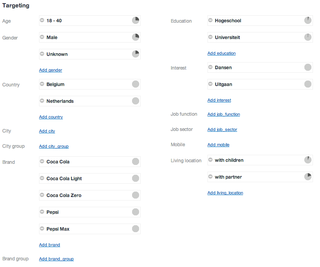
Advertising is a marketing communication that employs an openly sponsored, non-personal message to promote or sell a product, service or idea. Sponsors of advertising are typically businesses wishing to promote their products or services. Advertising is differentiated from public relations in that an advertiser pays for and has control over the message. It differs from personal selling in that the message is non-personal, i.e., not directed to a particular individual. Advertising is communicated through various mass media, including traditional media such as newspapers, magazines, television, radio, outdoor advertising or direct mail; and new media such as search results, blogs, social media, websites or text messages. The actual presentation of the message in a medium is referred to as an advertisement.

Sex appeal is often used in advertising to help sell a particular product or service. According to research, sexually appealing content, such as imagery, used for marketing does not need to pertain to the product or service in question. Rather, such content is utilized as an attempt to shape or shift brand image held by the consumer. As more companies have adopted the ad strategy of "sex sells", the prevalence of sexual campaigns has led to controversy. Consumers in society have voiced concern over the techniques and content used for titillating audiences, often stemming from the fact that such ads challenge conventional morals and cultural standards.
Digital display advertising is graphic advertising on Internet websites, apps or social media through banners or other advertising formats made of text, images, video, and audio. The main purpose of display advertising is to deliver general advertisements and brand messages to site visitors. A display ad is usually interactive, which allows brands and advertisers to engage deeper with the users. A display ad can also be a companion ad for a non-clickable video ad.
Selective perception is the tendency not to notice and more quickly forget stimuli that cause emotional discomfort and contradict our prior beliefs. For example, a teacher may have a favorite student because they are biased by in-group favoritism. The teacher ignores the student's poor attainment. Conversely, they might not notice the progress of their least favorite student.
The spacing effect demonstrates that learning is more effective when study sessions are spaced out. This effect shows that more information is encoded into long-term memory by spaced study sessions, also known as spaced repetition or spaced presentation, than by massed presentation ("cramming").
A longitudinal study is a research design that involves repeated observations of the same variables over short or long periods of time. It is often a type of observational study, although it can also be structured as longitudinal randomized experiment.

Advertising management is a planned managerial process designed to oversee and control the various advertising activities involved in a program to communicate with a firm's target market and which is ultimately designed to influence the consumer's purchase decisions. Advertising is just one element in a company's promotional mix and as such, must be integrated with the overall marketing communications program. Advertising is, however, the most expensive of all the promotional elements and therefore must be managed with care and accountability. Advertising management process also helps in defining the outline of the media campaign and in deciding which type of advertising would be used before the launch of a product.

An advertising campaign is a series of advertisement messages that share a single idea and theme which make up an integrated marketing communication (IMC). An IMC is a platform in which a group of people can group their ideas, beliefs, and concepts into one large media base. Advertising campaigns utilize diverse media channels over a particular time frame and target identified audiences.

Alcohol advertising is the promotion of alcoholic beverages by alcohol producers through a variety of media. Along with tobacco advertising, alcohol advertising is one of the most highly regulated forms of marketing. Some or all forms of alcohol advertising are banned in some countries. There have been some important studies about alcohol advertising published, such as J.P. Nelson's in 2000.
Music in advertising refers to music integrated into mass electronic media advertisements to enhance its success. Music in advertising affects the way viewers perceive the brand by different means and on different levels, and "can significantly affect the emotional response to television commercials." It also affects the musicians whose music is featured in advertisements.

Fallon is a full-service advertising agency headquartered in Minneapolis, Minnesota, with affiliate offices in London, Detroit, and Tokyo. It is a subsidiary of Publicis.
Advertising research is a systematic process of marketing research conducted to improve the efficiency of advertising. Advertising research is a detailed study conducted to know how customers respond to a particular ad or advertising campaign.
Ad tracking, also known as post-testing or ad effectiveness tracking, is in-market research that monitors a brand’s performance including brand and advertising awareness, product trial and usage, and attitudes about the brand versus their competition.
Brand awareness is the extent to which customers are able to recall or recognize a brand under different conditions. Brand awareness is one of two dimensions from brand knowledge, an associative network memory model. Brand awareness is a key consideration in consumer behavior, advertising management, and brand management. The consumer's ability to recognize or recall a brand is central to purchasing decision-making. Purchasing cannot proceed unless a consumer is first aware of a product category and a brand within that category. Awareness does not necessarily mean that the consumer must be able to recall a specific brand name, but they must be able to recall enough distinguishing features for purchasing to proceed. Creating brand awareness is the main step in advertising a new product or bringing back the older brand in light.

Targeted advertising is a form of advertising, including online advertising, that is directed towards an audience with certain traits, based on the product or person the advertiser is promoting. These traits can either be demographic with a focus on race, economic status, sex, age, generation, level of education, income level, and employment, or psychographic focused on the consumer values, personality, attitude, opinion, lifestyle and interest. This focus can also entail behavioral variables, such as browser history, purchase history, and other recent online activities. Targeted advertising is concentrated in certain traits and consumers who are likely to have a strong preference. These individuals will receive messages instead of those who have no interest and whose preferences do not match a particular product's attributes. This eliminates waste.
Performance-based advertising, also known as pay for performance advertising, is a form of advertising in which the purchaser pays only when there are measurable results. Performance-based advertising is becoming more common with the spread of electronic media, notably the Internet, where it is possible to measure user actions resulting from advertisement. Performance Marketing is different from Brand Marketing which focuses on awareness, consideration and opinions among target consumers.
Henry L. "Roddy" Roediger III is an American psychology researcher in the area of human learning and memory. He rose to prominence for his work on the psychological aspects of false memories.
Thinkbox is the marketing body for commercial TV in the UK. Its shareholders are Channel 4, ITV, Sky Media and UKTV. Together Thinkbox's shareholders represent over 99% of commercial TV advertising revenue through their owned and partner TV channels. Thinkbox's Associate Members are Disney, TAM Ireland, Think TV (Australia), thinktv (Canada), TVN Media (Poland), TV Globo (Brazil), Tenk TV (Norway), DSTv, and Virgin Media. Discovery Networks UK & Ireland and STV also give direct financial support.
The encoding specificity principle is the general principle that matching the encoding contexts of information at recall assists in the retrieval of episodic memories. It provides a framework for understanding how the conditions present while encoding information relate to memory and recall of that information.
An annoyance factor, in advertising and brand management, is a variable used to measure consumers' perception level of annoyance in an ad, then analyzed to help evaluate the ad's effectiveness. The variable can be observed or inferred and is a type that might be used in factor analyses. An annoyance effect is a reference to the impact or result of an annoying stimulus, which can be a strategic aspect of an advertisement intended to help a message stick in the minds of consumers. References to annoyance effects have been referred to as annoyancedynamics. While the words "factor" and "effect," as used in the behavioral sciences, have different meanings, in casual vernacular, they have been used interchangeably as synonymous. A more general or umbrella term would simply be advertising annoyance.






